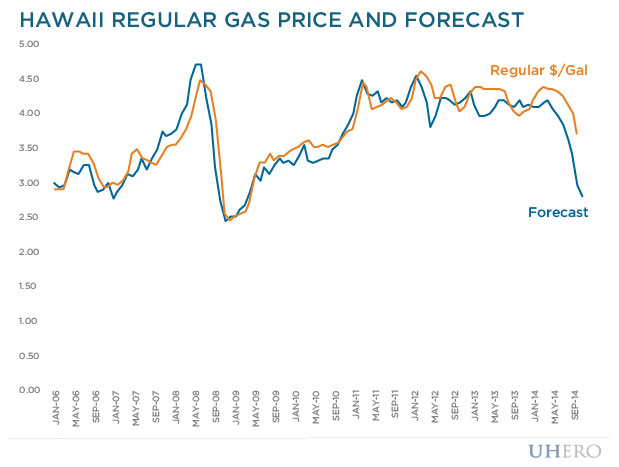By Carl Bonham
The drop in crude oil prices from $112/ barrel in June of 2014 to $46/barrel today will, if sustained, provide a nice boost to Hawaii’s economy. Beyond the gains that Hawaii’s tourism industry will see from lower energy costs, there is a direct effect on local households, businesses and government that is larger than you might expect. It is well known that Hawaii is the most oil dependent state in the country, and so it stands to reason that we will benefit significantly from a drop in the cost of petroleum. A few quick back-of-the envelope calculations illustrate this point.
In 2014, Hawaii businesses, households, government and visitors consumed gasoline at a rate of 449 million gallons/year, 4 million more than were consumed in 2013. The average price of a gallon of regular gasoline has fallen by $1 from a high of $4.40 in the spring of 2014 to about $3.40 today. If oil prices average $55/barrel for all of 2015, our models suggest gasoline prices will fall below $3 per gallon, saving Hawaii more than $600 million. Of course oil prices could bounce back sharply from lows in the $40s, but even an average of $70/barrel will lead to savings of over $400 million. To put that in perspective, $600 million amounts to almost 1.5% of total consumption, and nearly 1% of Hawaii’s Gross Domestic Product (GDP).

Of course these simple calculations are just that, simple. We are likely to see some increase in consumption of energy due to falling prices, not all of the savings will be spent, and some of the savings accrue to businesses that may or may not pass on savings to their customers. But the research on the impact of oil price movements suggests consumers can respond with even larger changes in spending than the changes in their energy budgets, particularly on durable goods (autos).
These calculations only reflect the impact via lower gasoline prices. Hawaii imports an average of almost 2.6 million barrels of foreign crude each month. Oil is used to produce gasoline, jet fuel, and fuel that generates most of our electricity. If the oil we import is 50% cheaper in 2015 than it was in 2014, we can expect savings of close to $1.4 billion, or nearly 2% of GDP.
These back of the envelope calculations are crude (no pun intended), but they make it clear that Hawaii’s economy can expect a boost in 2015 if energy costs remain anywhere near their current low levels.
BLOG POSTS ARE PRELIMINARY MATERIALS CIRCULATED TO STIMULATE DISCUSSION AND CRITICAL COMMENT. THE VIEWS EXPRESSED ARE THOSE OF THE INDIVIDUAL AUTHORS. WHILE BLOG POSTS BENEFIT FROM ACTIVE UHERO DISCUSSION, THEY HAVE NOT UNDERGONE FORMAL ACADEMIC PEER REVIEW.





